If you’re reading this, you’re probably creating, generating, recording or effecting sound of some kind.
Whether you’re into music, film, broadcast or content creation, Sound Devices produce something for each industry’s own set of nuances and technical considerations that require slightly different tact at both the workflow and device level.
The logistics of recording music in a traditional studio often requires expansive, heavy, hulking equipment by virtue of the stationary nature of the environment that studios inhabit; the kind of channel counts and open microphones required to accurately capture a band playing in a room. Recording for film and Television on the other hand, is a much more nimble affair, with recordists often employing on location devices and field recorders – mobility, build quality, redundancy and speed of workflow being paramount to a successful shoot.
Read all the latest features, columns and more here.
For over 20 years, Sound Devices have been on the cutting edge of these kinds of mobile professional solutions, becoming one of the most trusted names in the space and developing a reputation for build quality and technical innovation that has pushed the product category into exciting new territory.
Where things get particularly interesting, is the way in which many of these innovations parlay seamlessly into mobile band recording, with Sound Devices’ MixPre Series offering 5, 8 and 12 track iterations that double as awesome, small footprint recording options for ensemble tracking – even beyond their obvious capabilities in the field and on the film set.
The MixPre-10 II, with its eight XLR inputs, is a great option for both film professionals and itinerant musicians/recording engineers in need of a simple, high quality remote recording solution. With eight onboard preamps, 12-track recording functions, 32-Bit float combined with bombproof professional build quality (a hallmark of equipment in the film and TV industry), it’s one of those products that will endure for years to come, simply due to its ability to constantly redefine its appropriateness across multiple applications and disciplines.
The robust chassis has control for the eight preamps on the front panel, as well as a record/play/next/previous control in a dazzling metallic red. The front panel communicates input and output information via a (sunlight-readable) colour touch screen. The left and right sides feature four inputs a side, Neutrik XLR/¼” combo jacks no less, and a USB-C output for connection to a computer. The back panel however, has space for an SD Card to record directly to. The unit also features a USB-A connection for use with control surfaces.

It’s this aforementioned ability to record directly to an SD card or other storage device (combined with the MixPre-10 II’s ability to run on AA or Sony L-mount batteries) that distinguishes this product from traditional band recording workflows, making for an incredibly adept mobile solution for live recording.
The onboard pres on the MixPre II series are Sound Devices’ own ultra-low-noise Kashmir preamps, which offer crystalline clarity and lightning fast transient response to go with their impressive 142dB of dynamic range. It’s these qualities that make them equally adept at capturing diction and foley as they are guitar amps and ensembles in the open air.
With built-in limiters to prevent clipping as well as onboard adjustable low cut filters (40hz-160hz), there is an impressive amount of control at the hardware level, serving as a handy ‘set and forget’ solution for quickly laying down a rehearsal or demo track. Not notably colourful, but far from clinical or cold sounding, the Kashmirs serve as a great way to capture audio quickly and easily, without the risk of overcooking it.
For film and TV more specifically, the MixPre-10 II also has multiple syncing and clocking options either via BNC word clock, HDMI or by the default internal timecode. All the major protocols are represented, with free run, ToD, Rec Run, Ext LNC and Camera TC options easily selected from the MixPre-10 II’s onboard screen. It is this flexibility of application that is undoubtedly one of the MixPre-10 II’s strong suits. By combining the utilitarian build quality and versatilityS required within the film industry, with the expanded I/O commonly seen in multitrack recording, the result is something that liberates the band (or production crew) from the studio or soundstage; ideal for capturing on-location sound, band rehearsals or even live performances.

The MixPre range extends to the MixPre-6 II and MixPre-3 II, offering 4 preamps/8 tracks and 3 preamps/5 tracks respectively. Both the 6 and 3 have the same capabilities to record direct to SD Card as the 10, while also having similar USB connectivity and timecode connections for film and TV.
Perhaps one of the more coveted features of the MixPre II series is the presence of 32-bit Float, providing ample headroom for the kinds of large fluctuations in dynamic range that one normally encounters in full band recording, field audio, sound effects and the like. The primary drawcard with 32-bit Float is its ability to exceed the 0dBFS limit, free of distortion. This is particularly handy for applications with wild, fluctuating dynamics, from a quiet whisper to a loud roar on a film set or a guitarist with poor gain staging across their pedalboard. The beauty in 32-bit Float is in its ability to accommodate and capture these kinds of audio events in as truthfully and usable a manner as possible for post, which makes a tonne of sense when you consider on-set workflows and what’s at stake for missing that perfect take.
Whether you’re recording those demos, or finding foley and ambience to add texture to your music, Sound Devices have something for you. Their products effortlessly straddle the line between mediums, being designed and built around the standard for film and TV sound recordists, but packed full of features that make it really easy to have well-recorded sound at the end of a session for all applications, be it film, music or something else.
Keen to keep reading? Find more here.

